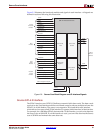
SPI-4.2 Lite v4.3 User Guide www.xilinx.com 33
UG181 June 27, 2008
Source Core Interfaces
R
Source Control and Status Interface
The Source Control and Status signals either control the operation of the entire Source core
or provide status information that is not associated with a particular channel (port) or
packet. Table 2-11 defines the source control and status signals.
Table 2-11: Source Control and Status Signals
Name Direction
Clock
Domain
Description
Reset_n Input n/a Reset_n: This active low, asynchronous control signal enables you to restart the
entire Source core. This means that the core will go out-of-frame. While Reset_n
is asserted, the Source core transmits idles cycles on TDat. Coming out of
Reset_n, the Source core transmits training patterns.
Following the release of Reset_n, the Source Calendar should be programmed
if the calendar is to be initialized in-circuit.
SrcFifoReset_n Input SrcFFClk SrcFifoReset_n: This active low control signal enables you to reset the Source
FIFO and the associated data path logic. This enables the FIFO to be cleared
while remaining in frame.
Upon Source FIFO Reset, the Source core sends idle cycles until you writes data
into the FIFO.
SrcEn Input SrcStatClk Source Enable: Active high signal that enables the Source core. When SrcEn is
deasserted, the Source core will not store or verify received status information.
The Source core will also assert SrcOof, and deassert SrcDIP2Err and
SrcPatternErr. When SrcEn is deasserted, the Source core will transmit training
patterns on TDat.
SrcOof Output SrcFFClk Source Out-of-Frame: When this signal is asserted (active high), it indicates
that the SPI-4.2 Lite Source core is not in frame. This signal is asserted when the
Source core has lost synchronization on the transmit FIFO status interface. This
is caused by the receipt of consecutive DIP-2 parity errors (determined by the
parameter NumDip2Errors), invalid received status frame sequence (of four
consecutive frame words "11"), or when SrcEn is deasserted.
This signal is deasserted once the Source core reacquires synchronization with
the SPI-4.2 transmit Status Channel. Synchronization occurs when consecutive
valid DIP2 words (determined by the Static Configuration signal
NumDip2Matches) are received and SrcEn is asserted.
SrcOofOverride Input SrcFFClk Source Out-of-Frame Override: When this signal is asserted, the source core
behaves like it is in frame and sends data on TDat, regardless of the status
received on TStat. This signal is used for system testing and debugging.
SrcDIP2Err Output SrcFFClk Source DIP-2 Parity Error: When this signal is asserted (active high), it
indicates that a DIP-2 parity error was detected on TStat. This signal is asserted
for one clock cycle each time a parity error is detected.
SrcStatFrameErr Output SrcFFClk Source Status Frame Error: When this signal is asserted (active high), it
indicates that a non “11” frame word was received after DIP2 on TStat. This
signal is asserted for one clock cycle each time an error frame word is detected.


















